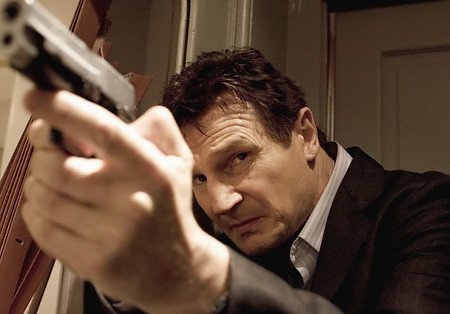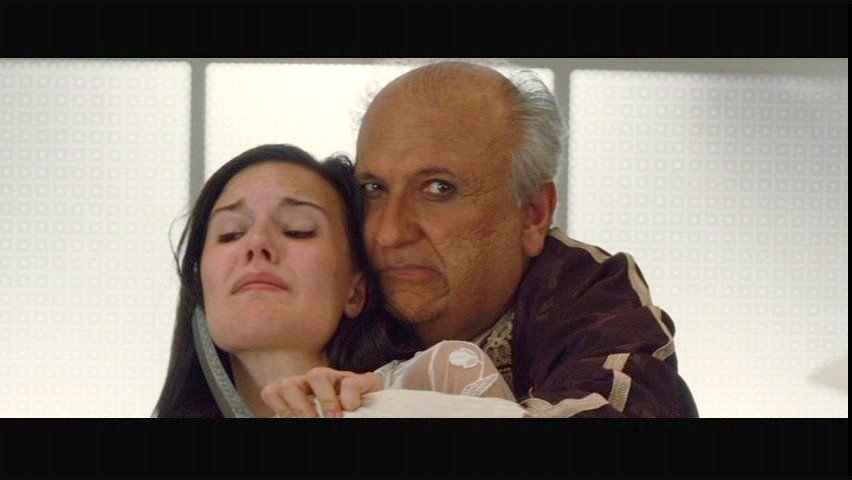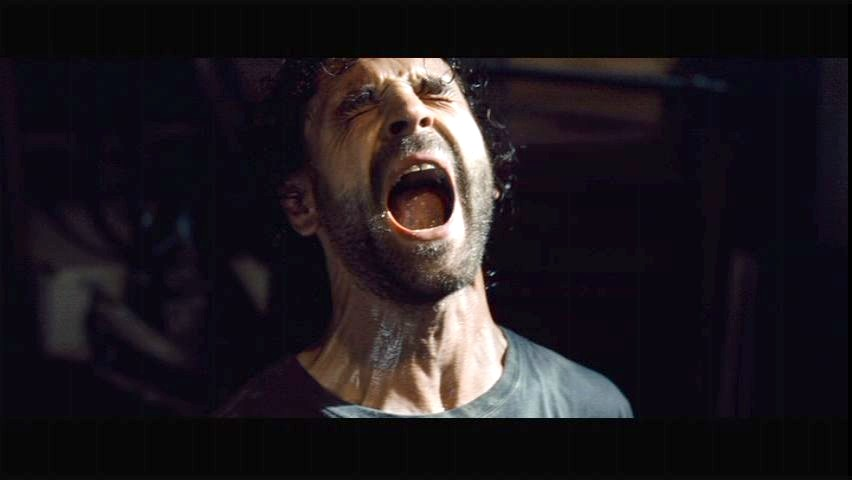The Evil Among Us: Liam Neeson in “Taken”
Israel is (in)famous for its “false flag” operations, covert provocations meant to create blame for innocent parties or nations. For instance, in the 1950s Israelis propagated the Lavon Affair, in which Jewish operatives in Egypt attempted to blow up American- and British-affiliated buildings and place the blame on Egyptians. In theory, this would have compelled the Americans and British to take punitive action against Egypt. As it turned out, the agents were captured before the bombs went off.
A far more subtle technique aimed at achieving goals surreptitiously is called “laying the mental threads” for a form of unconventional warfare employing game theory to get others to fight your enemies for you. Relentlessly, people’s minds have been exposed to scenarios of Arab enemies and terrorists, a signal example being the broad attention given to Harvard historian Samuel Huntington’s “Clash of Civilizations” thesis. A major element of that clash is the West’s struggle against Muslims. America’s (mistaken) response to 9/11, some have claimed, illustrates this.
In American popular culture, Arabs are the only non-White group that can be openly attacked and vilified. For evidence, Jack Shaheen’s The TV Arab (1984) chastised television for creating and perpetuating a noxious image of Muslim Arabs. A second book, Guilty: Hollywood’s Verdict on Arabs After 9/11 (2008) shows that Hollywood portrays Arabs as terrorists, corrupt sheiks, or exotic, camel-riding primitives. Reel Bad Arabs: How Hollywood Vilifies a People (2009), canvassed 900 films, “the vast majority of which portray Arabs by distorting at every turn what most Arab men, women, and children are really like.”
The issue is not really whether these images have a substantial element of truth. Muslims are indeed the most likely people on the planet these days to be terrorists. The point is that Hollywood is certainly not prone to providing true images of Blacks, Jews, or Latinos. Rather, it air brushes them to make them appealing to White audiences and paint a reassuring picture of the multicultural future. Hollywood excels at soothing the fears of its largely White audience about their future minority status. Again, Arabs are are the only non-White group that is not given a free pass in the multicultural West.
Is it possible that such imagery is not only the result of widespread Jewish fear and dislike of Arabs because of Arab hostility to Isarel, but also part of a larger plan to get Americans to fight Israel’s wars? After all, in addition to film and TV, we had the myriad neocon think tank studies suggesting that a “new Pearl Harbor” might serve as catalyst for a power reconfiguration in the Middle East. David Ray Griffin, author of The New Pearl Harbor Revisited: 9/11, the Cover-Up, and the Exposé, suggests that American minds were “prepared” for 9/11. For example, the popular series “The X-Files” had a spin-off called “The Lone Gunmen.” Griffin writes that “In March 2001, the pilot episode of The Lone Gunmen, which reportedly had 13 million viewers, was based on a rogue group within the US government crashing a remote-controlled 747 into the World Trade Center.” (Watch the scene here).
An even better example is the big-budget film The Siege (1998). This action-packed thriller stars Denzel Washington as an FBI agent tracking Arab terrorists in New York. If indeed the media has been “preparing the minds” of Americans for future events, then The Siege fits the mold. For instance, Arab terrorists blow up themselves and a busload of innocent passengers in broad daylight (think suicide bombers in Israel). Then comes an attack on a theater. Finally, we have a scene that is more than suggestive of the airliner crashes into the Twin Towers: Arabs drive a van loaded with explosives into the FBI Counterterrorism Division at One Federal Plaza, raining debris down on New York streets. Here we are now, nearly ten years after 9/11. We are still in Iraq and Afghanistan, and yet again the calls for an immediate attack on Iran are escalating. And Hollywood (which is, needless to say, a Jewish fiefdom) continues its role in “preparing the minds” of Americans for this attack by churning out horrendous images of Muslims and Arabs. (I know Iranians are not Arabs, but that is a point totally lost on Western people.)
Now, it seems, the French have entered the cultural fray and portrayed Arabs in a fashion more common to Hollywood. The 2008 hit Taken, starring Irish actor Liam Neeson as a retired CIA operative, could have come straight from Tinseltown. Directed by Pierre Morel and produced by “Cinéma du look” prodigy Luc Besson, its style and action fit in seamlessly with Hollywood super-agent flicks such as The Bourne Identity and Mission: Impossible, not to mention Besson’s own Nikita. The film was written by Besson and Robert Mark Kamen, author of Growing up Hasidic: Education and Socialization in the Bobover Hasidic Community.

Despite considerable French involvement, it is an American film with American characters playing the roles that the audience identifies with. Neeson even nicely Americanizes his Irish accent in the film. It’s no accident then that the film performed very well in the North American market, which yielded around $145,000,000 of the worldwide gross of $227,000,000.
In other words, it’s a movie that was successfully designed to appeal to the American market by trading on one of Hollywood’s favorite themes: negative stereotypes of Arabs.
The premise of the film is simple: Neeson plays Bryan Mills, a divorced husband living in Los Angeles who wants to be near his 17-year-old virgin daughter Kim. I need to mention that she is a virgin because that is central to the story: When she and her classmate take a trip to Paris to follow a tour of the Irish rock band U2, they are kidnapped by a prostitution ring. The friend dies but Kim is set to be auctioned off to the highest bidder. Bids will be high as Kim is “certified pure.” Mills puts to work his spy and martial arts skills and sets off to rescue her.
The group that has kidnapped her is the Albanian Mafia, while the buyers are Arabs. We know this because the bidder planning to deflower Kim is one “Sheik Raman.” What could be a better motive to find and punish such evildoers? Needless to say, for a father to do all he can to protect his young daughter is both understandable and highly admirable. Morality is fully behind him on this, and no degree of extra-legal behavior need be disallowed.
The subtext of Taken is unmistakably in the mold of Hollywood’s defamation of Muslims.To begin with, the two American teenage girls are abducted from a Paris apartment by vicious Albanians. Two thoughts cross my mind here. First, few Americans are likely to have any knowledge whatsoever of Albanians, so in a sense the filmmakers are given a blank slate on which to draw their image of the bad guys. Second, among the Albanian population, there is a heavy Muslim presence (~70%) so this would support that anti-Muslim aspect of the film.
If the Albanian kidnappers are uncouth, the Arabs who appear are at least clean. The sheik’s underling is even quite suave, with stylishly coiffed hair and fine clothes. The sheik, however, is repulsive. With pockmarked brown skin and a bald pate, he is repulsive. And he was within minutes of deflowering 17-year-old Kim.

Nabil Massad as Sheik Raman
While the storyline of Taken is easily forgettable, the underlying images of the violent, unclean, or lecherous Muslim are reinforced. This is what prompts me to insist that the film is part of the larger Hollywood effort to defame Muslims and Arabs—very useful if your aim is to go to war against pretty much the entire Muslim world. Perhaps a key point comes with the fact that the American distributor of Taken is none other than 20th Century Fox, which is owned by the noted neocon Rupert Murdoch. Fox has a history of denigrating Arabs, as independent scholar E. Michael Jones’s showed in the April 2009 and January 2010 issues of his journal Culture Wars. In the article “Abu Ghraib, Torture, and the American Empire,” he tied Israelis to the torture of Iraqis by American troops, plus delved into the larger question of how Hollywood has been playing a role in “preparing the minds” of the American public for the mainstreaming of torture. Drawing from a New Yorker profile of the co-creator and executive producer of “24,” Joel Surnow, Jones quoted a description of the show:
Each season of “24,” which has been airing on Fox since 2001, depicts a single, panic-laced day in which Jack Bauer—a heroic C.T.U. agent, played by Kiefer Sutherland—must unravel and undermine a conspiracy that imperils the nation. Terrorists are poised to set off nuclear bombs or bioweapons, or in some other way annihilate entire cities. The twisting story line forces Bauer and his colleagues to make a series of grim choices that pit liberty against security. Frequently, the dilemma is stark: a resistant suspect can either be accorded due process—allowing a terrorist plot to proceed—or be tortured in pursuit of a lead. Bauer invariably chooses coercion. With unnerving efficiency, suspects are beaten, suffocated, electrocuted, drugged, assaulted with knives, or more exotically abused; almost without fail, these suspects divulge critical secrets.
Multitasking, Jewish producer Joel Surnow, whose politics “suffuse the whole show,” has also consistently allowed portrayals of Muslims as terrorists to appear. The most egregious image of Muslims probably came with the introduction in season four of the immigrant Araz family, composed of father Navi, mother Dina, and 17-year-old son Behrooz. Though Behrooz dates an American girl, the family is vile and corrupt in almost every other way. The entire family is on a knowing mission to destroy large parts of the United States with nuclear weapons. Father Navi exhibits his vileness by telling his son things such as “I listen to your phone calls, I read your e-mail” and striking him on the face.
This is nothing, however, compared to the father’s decision to murder his own son. Fearing the American girlfriend will expose the terrorist plot, Navi orders Behrooz to cold-bloodedly murder her. Suspecting Behrooz does not have the inner strength to do so, mother Dina poisons the girlfriend by spiking her tea. Dina is at least considerate enough to then shoot the girl’s body in an attempt to persuade her husband that Behrooz had carried out orders. Next, as Behrooz and one of his father’s henchmen are digging the girlfriend’s grave, the henchman tries to kill Behrooz. Incapacitating the attacker, Behrooz demands to know who ordered his death: It is his own father Navi. Jones is right to conclude that “Hollywood has always been a Jewish empire, so it is not surprising that when it merged with government, government would become more Jewish as well.”

- “Marko” the Albanian slave trader learns he has kidnapped the wrong girl
Finally, Taken is guilty of the same subterfuge and mind control that many Hollywood movies are: it creates images of non-Jewish evildoers when in fact the crimes are far more representative of Jewish crimes. In this case, egregiously so. Ten years ago, a weekend edition of the Jerusalem Post featured a story about the widespread problem of prostitution and sexual slavery in Israel. Trading in non-Jewish slaves, it seems, is not illegal there. And many of these young women are from Eastern European countries.
In their June 16, 2000 issue, they wrote: “In Israel it is legal to buy and sell slaves, as long as they aren’t Jews. The slave trade is big business in Israel, and it’s legal.”
Every year hundreds of women, and an unknown number of girls under the age of 18, are bought, sold, drugged, imprisoned, and forced to work as prostitutes in Israel’s thriving sex industry. In countries such as Russia, Ukraine, Latvia, and Hungary, traffickers prey on desperate women. Facing poverty, the women are lured to Israel with the promise that they will make fabulous salaries working as teachers or caregivers.
Now think about that: “Every year hundreds of women, and an unknown number of girls under the age of 18, are bought, sold, drugged, imprisoned, and forced to work as prostitutes in Israel’s thriving sex industry.” Then compare it to the plot-line of Taken, where two girls under the age of 18 are kidnapped, drugged, imprisoned and readied for sale to the highest bidder. Further, we see that other girls kidnapped by the Albanian Mafia have already become addicted to heroin and are selling their bodies on the streets of Paris to turn a profit for their masters.
Marlon Brando, a Hollywood insider if there ever was one, knew about this subterfuge. On Larry King Live he said “Hollywood is run by Jews, it is owned by Jews, but we never saw the kike because they know perfectly well that’s where you draw the wagons around.”
This is so true. Name one scene where you see someone who is clearly identified as a Jew committing massive financial fraud or controlling Presidents. Or raping underage non-Jewish girls. Or buying and selling them for the sex trade in Israel.
Or even throwing lavish parties. Another instance in Taken where stereotypically Jewish behavior is acted out by non-Jews is Kim’s lavish 17th-birthday party. We see an opulent L.A. mansion decked out for the affair. Kim’s non-Jewish stepfather is fabulously wealthy and gives Kim an expensive horse as a gift.
The funny thing is, it is Jews who are famous for lavish displays of personal wealth: for throwing extravagant bar mitzvahs, birthday parties, weddings, and just regular parties.
One that really caught my attention is the story about the owner of a Long Island firm that specializes in making bulletproof vests for the U.S. military, vests which many critics claim are defective. CEO David Brooks has been in deep trouble, as ABC reports:
A class action lawsuit, which was recently settled for some $35 million, charged Brooks and his top executives with issuing misleading financial statements and then selling over 10 million of their own shares in the company and receiving over $200 million in illegal profits. . . . Following that stock sale, Brooks again raised eyebrows when he threw his daughter a lavish bat mitzvah, which reportedly cost $10 million. The party featured performances by Aerosmith and rapper 50 Cent and took place at the New York’s famed Rainbow Room.
This deception is no doubt what so aggravated film critic James Jaeger, prompting him to excoriate Jewish director Paul Haggis for his racial and ethnic depictions in Crash, the 2005 Oscar winner for Best Picture. Echoing Brando, Jaeger notes the film’s ensemble of a diverse array of characters “crashing” into each other in a racially tense Los Angeles, but charges that “Nowhere is it shown that Jews also CRASH into Blacks, Whites, Latinos, Iranians, Asians, and Persians and profoundly affect THEIR lives—especially in Hollywood where CRASH is set and Jews comprise a dominating minority in the Los Angeles area.”
Rather, Jaeger sees the same old display of select diversity on-screen but no mention of the lack of diversity behind-the-scenes. “Why doesn’t Paul write a feature that is set in the executive suites of say Warner Bros. or Paramount where the dominating minority is properly and accurately acknowledged as Jewish?”
So what can I finally say about Taken? In one sense, it provides a useful function by again alerting Americans, French and other Westerners to the risk posed by the presence of alien elements among us. While terrorism is one clear risk, it is not the only one, as Taken shows. But I’m still bothered by the fact that it projects the behavior of evildoers onto enemies of Jewry. That so many Westerners could not only overlook these facts but in essence worship Jews and Israelis is almost impossible for me to understand. Is this because they are taken in by the cagey projection technique employed so often by Jews?






Comments are closed.